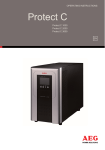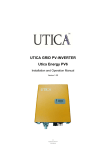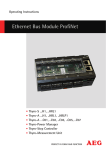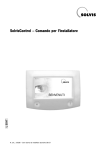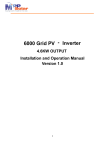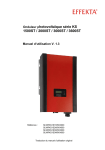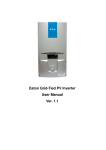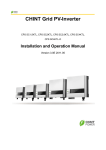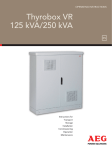Download PV Powered 4600 Operating instructions
Transcript
1 OPERATING INSTRUCTIONS PRotEct PV 4600 on-gRid solaR inVERtER En Version 17.03.2011 / Rev 04 2 Contents Read this User Manual before you start 3 1. Safety Instructions 4 2. Limited Warranty 5 3. Overview 3.1 Introducing the grid-connected PV System 3.2 Introducing the Grid PV System 3.3 Front Panel LEDs 8 8 9 10 4. Features 11 5. Installation 5.1 Inside Protect PV 4600 Package 5.2 Mounting your Protect PV 4600 5.3 Connecting the AC-Output Cable 5.4 Connecting the PV-Panel 5.5 Connecting to the connection unit 5.6 Installation checklist 12 12 12 17 20 21 22 6. Operation of the Protect PV 4600 6.1 Auto-power 6.2 Operating Modes 6.3 Using the LCD Display 6.4 Maximum Power Point Tracking (MPPT) 6.5 LCD Display Messages 24 24 24 26 30 31 7. Communication Interface 7.1RS232 7.2 Optional Communications Interface 33 33 33 8. Troubleshooting 34 9. Specifications 36 10. Compliance of Standards 37 11. Load Graph and Efficiency Graph 38 3 Read this User Manual before you start Congratulations for purchasing your Protect PV 4600 grid-connected PV-Inverter from AEG Power Solutions GmbH (referred to in this manual as “PV-Inverter”, or simply the “device”). This PV-Inverter is a highly reliable product due to its innovative design and perfect quality control. The device is dedicated to high-demand, grid-linked PV systems. This manual contains important information regarding installation and safe operation of this unit. Be sure to read this manual carefully before using your PV-Inverter. If you encounter any difficulties during installation or operation, please refer to this manual before contacting your local dealer or representative. To obtain the latest manual and product information, please contact the inverter’s manufacturer. Thank you for choosing our product. Please keep this manual on hand for quick reference. Start enjoying Protect PV 4600 and your life! 4 1. Safety Instructions 1. Risk of Electric Shock: Alternating Current (AC) and Direct Current (DC) sources are terminated in this device. To prevent risk of electric shock during maintenance or installation please ensure that all AC and DC terminals are disconnected. 2. Handling your PV-Inverter: The PV-Inverter should only be handled by qualified service personnel. When the PV-panel is exposed to sunlight and connected to the device, it generates a DC voltage charging the DC link capacitors. After disconnecting the PV-Inverter from the power supply and PVpanel, electrical charge can still reside in the DC link capacitors. The device shall be touched by qualified personnel earliest 60 minutes after disconnecting. 3. Public supply mains only: The PV-Inverter is designed to feed AC power directly to the public supply mains. Do not connect the AC-output of this device to any private AC equipment. 4. Beware of hot Surfaces: Although designed to meet international safety standards, the PVInverter can become hot during operation. Do not touch the heatsink or peripheral surfaces during or shortly after operation. 5 2. Limited Warranty The limited warranty provided by AEG Power Solution (“AEG PS”) in this Statement of Warranty applies only to Equipment purchased for residential, commercial or industrial use in the ordinary course of the business. Terms of warranty AEG PS warrants that it is sufficiently experienced, properly qualified, registered, licensed, equipped, organized and financed to perform the Work in compliance with the terms of this Agreement. AEG PS warrants that the Equipment shall be free from defects in design, materials and workmanship for a period of sixty (60) months from the date of commissioning when AEG PS authorized service personnel performed the commissioning and start-up of the Equipment, but not longer than sixty six (66) months from the date of notification that the goods are ready for dispatch, whichever occurs first. In the event that the Equipment fails to meet the foregoing warranty, AEG PS undertakes to repair and/or replace any part found to be faulty due to errors in design or manufacture, or to be made of faulty materials if trained & authorized AEG PS personnel has conduct commissioning and start-up of the Equipment. An AEG PS Commissioning and Start-Up Service must be performed/ completed by AEG PS or by authorized service personnel. If not, the on-site Warranty will be voided and replacement of defective parts only will be covered. AEG PS shall have no liability and no obligation to repair the installed Equipment if non-authorized personnel performed the start-up and such start-up caused the Equipment to be defective. In addition, the Warranty does not cover defects originating from the materials provided by the Purchaser, a design imposed by the Purchaser, incidents brought about by contingencies or acts of God or any other cause the vendor could not reasonably be expected to foresee or whose consequences it could not prevent, repairs or replacements imposed by normal wear and tear of the equipment, damage or accidents brought about by the Purchaser‘s actions, such as negligence, connection error, failure to follow instructions for maintenance, abnormal use due in particular to electrical or mechanical overload. 6 Any parts furnished under this warranty may be new or factory-remanufactured. Repair or replacement of a defective Equipment or part thereof does not extend the original warranty period. The AEG PS reserves the rights to modify if necessary the mechanism of the equipment in order to fulfil this Agreement. Warranty claims procedure Should you be experiencing technical issues with your inverters, please have your installer or reseller report the case to the country specific AEG PS hotline. AEG PS service hotline numbers are available by consulting the www.aegps.com website. To better assist you, your installer will require having the following information readily available: - Caller’s contact information - Product type and serial number - Installation date - Problem occurrence date - Problem description and error code Should the service hotline conclude to a replacement of the inverter, your installer or reseller will be required to download and complete the appropriate RMA (Return Material Authorisation). A PDF version of the RMA document can be downloaded from the www.aegps.com website. The system replacement will be facilitated by following and accepting the general terms and conditions mentioned on the second page of the RMA document. Exclusions AEG PS shall not be liable under the Warranty if its testing and examination discloses that the alleged defect in the Equipment does not exist or was caused by your or any third person’s misuse, negligence, improper installation or testing, unauthorized attempts to repair or modify, or any other cause beyond the range of the intended use, or by accident, fire, lightning or other hazard. There are no warranties, expressed or implied, by operation of law or otherwise, of Equipment sold, serviced or furnished under this Agreement or in connection herewith. AEG PS disclaims all implied Warranties of merchantability, satisfaction and fitness for a particular purpose. The AEG PS express warranties will not be enlarged, diminished, or affected by and no obligation or liability will arise out of AEG PS rendering technical or other advice or service in connection with the Equipment. The foregoing warranties and remedies are exclusive and in lieu 7 of all other warranties and remedies. The warranties set forth above, constitute sole liability of AEG PS and purchaser’s exclusive remedy for any breach of such Warranties. The warranties extend only to purchasers and are not extended to any third parties. In no event shall AEG PS, its officers, directors, affiliates or employees be liable for any form of indirect, special, consequential or punitive damages arising out of the use, service or installation of the Equipment, whether such damages arise in contract or tort, irrespective of fault, negligence or strict liability or whether AEG PS has been advised in advance of the possibility of such damage. Warranty extension The original factory warranty can be extended by purchasing additional Extended Warranty Program which extends factory warranty by five (5) years from the date the original factory warranty is ending and guaranty repair and/or replacement of defective parts. Travelling time, expenses and board and accommodation costs will be charged to the Purchaser. The Extended Warranty must be purchased within the first 12 months of the inverter purchase. The Extended Warranty Program does not cover failure due to commissioning or Start-Up by non-authorized personnel, improper operation or use of the equipment, lack of maintenance, alterations to original design or a change in location or operating use. Extended warranty doesn’t cover wear and tear parts such as cooling fans. The other terms of Extended Warranty Program are defined in the Terms of warranty section. 8 3. Overview 3.1 Introducing the grid-connected PV System The grid-connected PV System is mainly composed of 4 parts: the PV-panels, the PV-Inverter, the AC-Connection Unit (the connection Interface) and a connection to the Public Grid. When a PV-panel is exposed to sunlight and connected to an inverter, it generates DC power. The PV-Inverter converts DC to AC and feeds in to the Public Grid via the AC-Connection unit. Inverter Grid (Public Utility) PV-Panel DC-Input AC Output AC-Connection Unit Feeding AC power to Public Utility only 9 3.2 Introducing the Grid PV System (7) F ront LCD Display Panel (3) 3-pairs of DC inputs (1) Connection Panel (2) Heat-sink (6) RS232 Connector (4) AC Output (5) O ptional Communication Port with Cover Protect PV 4600 Inverter (1) Connection Panel: The connection panel contains DC and AC terminals, and communication ports as detailed below. (2) Heat-sink: Part to dissipate heat produced by the inverter (3) 3 pairs of DC-input terminals: Each input pair consists of positive and negative terminals. Refer to Installation Section for set-up information. (4) AC-Output: Delivering AC to the Public grid. (5) Optional Communication Slot and Cover: An optional port to extend the communication interface, for example for connecting a RS485 card. The port is protected by a water-proof cover. (6) RS232 Port: Interface allows communication with computer via RS232 serial port. (7) LCD Display: Device to display inverter operation status. 10 3.3 Front Panel LEDs There are 2 LED’s on Protect PV 4600, one is green and the other is red. Normally, only the green LED is on during operation. The indicated status are explained as follows: Power on (green LED): The LED lights, if Protect PV is running. The LED lights not, if no power is provided to Protect PV inverter. In this case, Protect PV 4600 is in shutdown mode. Fault (red LED): The LED lights, if the inverter is in “fault” or “failure” condition. To see the conditions, please refer to section 8: LCD Display Function Button Power-on LED Fault LED Power-on Fault 11 4. Features • Very high conversion efficiency (> 96%) • 3 MPP tracker (Maximum Power Point), independent or parallel operation • IP65 compliant for outdoor application • Embedded LCD, displaying status and system information • Fanless design, quiet operation • Stylish design • Compact and unobtrusive • High reliability • Easy installation • Maintenance free • Standard RS232, optional RS485 and others • Embedded ENS, complying with VDE 0126 • Internal GFCI (Ground Fault Current Interrupter) 12 5. Installation 5.1 Inside Protect PV 4600 Package The following items are included in your Protect PV 4600 Package: (1) Protect PV 4600 PV-Inverter (2) Installation and Operation Manual (3) 4 Mounting Screws and 4 Blade receptacle (4) 2 Safety-lock screws (5) 3-hole Rubber Bushing (6) Mounting Bracket 5.2 Mounting your Protect PV 4600 Suggestions before mounting To obtain optimal results from your PV-Inverter, please consider the following guidelines before installing the device: Do not expose the PV-Inverter to direct sunlight. Direct sunlight increases the internal temperature that may reduce conversion efficiency. - Check the ambient temperature of installation is within specified range -20 ~ +55 °C. - The AC grid voltage is between 196 and 253 VAC, 50/60 Hz. - Electric utility company has approved the grid connection. - Qualified personnel are performing the installation. - Adequate convection space surrounds the inverter. - Inverter is being installed away from explosive vapors. - No flammable items are to be near the inverter. Protect PV can be installed and operated at locations where the ambient temperature is up to 55 °C. However, for optimal operation, it is recommended that Protect PV is installed where the ambient temperature is between 0 ~ 40 °C. 13 Mounting Protect PV to the wall 1. Choose a dry place, out of direct sunlight with ambient temperature between 0 and 40 °C. 2. Select a wall or solid, vertical surface which is strong enough to support the inverter. 3. The PV-Inverter requires adequate cooling space for heat dispersal. Reserve at least 20 cm above and below the inverter. Minimum space 20 cm Minimum space 20 cm 14 4. Mark the positions of the 4 outer mounting holes onto the wall with the bracket as illustrated: Using the Outer Mounting Holes Upper Mounting Holes Lower Mounting Holes Mounting Bracket 15 5. To install the device to a narrow surface, mark the 4 central holes at the back of the bracket. Using the CentRal MoUnting holes Upper Central Mounting Holes Lower Central Mounting Holes 6. Drill the 4 marked holes in the wall, and then drive in the 4 Snap Bushings. Now insert the screws and tighten them. oUteR MoUnting holes CentRal MoUnting holes 16 7. Mount the PV-Inverter onto the bracket as illustrated: Safety Lock Screw 8. Insert the Safety Lock screws to fix the PV-Inverter in place. 9. Install the device vertically to ensure the device is properly fixed to the bracket. LCD Display 17 5.3 Connecting the AC-Output Cable Connect your PV-Inverter to the AC-Connection unit via the AC-output cable as following steps: AC-Output Connector AC-Output Cable (≥ 2.0 mm²) AC connection unit (consisting of breaker, fuse, terminals etc.) (1) Open the AC-output cover with a screw driver. (2) Draw out the AC Connector set from the Inverter. 18 (3) U nscrew the cable lock and prepare your AC cable. AC cable lock (4) R emove the rubber plug from inside the AC connector socket. Rubber Plug (no hole in it) (5) Insert the provided rubber bushing with three holes into the AC connector socket. 3-hole Rubber Bushing 19 (6) Now insert the three wires of the AC cable into the bushing holes. (7) Fix the brown wire to L (Line); the blue wire to N (Neutral); and the yellow-green wire to G (Ground). All three wires should be firmly connected. L for Line N for Neutral G for Ground (8) After checking the 3 wires are fixed properly, push the AC-output connection set back in to the Connection Panel. Drive the 4 screws back to fix the set. 20 (9) N ow screw the Connector Locker in tight to fix the bushing and cable. 5.4 Connecting the PV-Panel (1) First make sure that the maximum open circuit voltage Voc of each PV string is below 750VDC UNDER ANY CONDITION. (2) A lways connect PV-Panel positive (+) terminal to PV-Inverter DC positive (+) terminal, and the PV-Panel negative (-) terminal to PVInverter DC negative (-) terminal. (3) E ach set of PV-Inverter DC terminals takes a maximum DC input of 8.5 A. As a result, 3 pairs of PV-Inverter DC terminals can take a combined input of up to 25.5 A. 21 (4) To fully optimize the PV DC output set-up, use the following configuration guidelines: (a) For PV DC output less than 8.5 A, use a single pair of PV-Inverter DC terminals. (b) For PV DC output between 8.5 A and 17 A, use two sets of inverter DC terminals. (c) For PV DC output between 17 A and 25.5 A, use 3 sets of inverter DC terminals. 5.5 Connecting to the connection unit The AC connection unit is an interface between your PV-Inverter and the Public grid. It may consist of an electrical breaker, fuse and terminals for connection to both PV-Inverter and the Public grid. This Connection unit must be designed by qualified technician to comply with local safety standards. AC-Output Port AC-Out Cable ( ≥ 2.0 mm²) AC connection unit (consisting of breaker, fuse, terminals etc.) 22 5.6 Installation checklist (1) H igh voltages exist when the PV-Panel is exposed to the sun. Exposed terminals of the PV-Panel are alive, and can cause electric shock. Avoid making physical contact with live parts of the device. (2) A fter the PV-Panels are connected to the PV-Inverter, the output voltage is higher than 100 VDC and the AC grid is not connected to the inverter, the LCD displays “Model= XXXXXX”-> “Waiting”-> “No Utility”. The RED “fault LED” turns on. Initial Display before Connecting to the Public Utility Function Button (3) Check the connection between your PV-Inverter and AC Connection System. And then check the connection between the Public grid and AC Connection unit. Close the AC breaker or fuse in the unit. (4) Under normal operation, the LCD displays: 23 The PV-Inverter is feeding power to the grid, and the green LED displays. Before connecting the PV-Panels to DC terminals, make sure the polarity of each connection is correct. An incorrect connection could damage the device permanently. (5) Congratulations, you have successfully installed your PV-Inverter! 24 6. Operation of the Protect PV 4600 LCD Display Function Button Power-on LED Fault LED 6.1 Auto-power The PV-Inverter starts up automatically once DC-power from the PVPanel is sufficient. There are 3 modes of operation. 6.2 Operating Modes 1. Normal In this mode, the PV-Inverter automatically detects the system status and selects the best mode of operation. If the power from the PV-Panel is higher than 150VDC, the supply is converted to AC and fed in to the grid. If the power is less than 100 VDC, the PV-Inverter displays “Waiting”. During the wait state, the device uses minimal power from the PV-Panel to monitor the system status. During normal mode, the green LED is on. 25 2. Fault The PV-Inverter’s intelligent controller continuously monitors the system status. Unexpected conditions such as grid problems or internal failures are displayed on the LCD and the “Fault LED” turns on. Faults are indicated by the red “FAULT” LED. 3. Shutdown At the moment of reduced sunlight, the PV-Inverter automatically shuts down. No power is used from the grid, the LCD display and LEDs on the front panel do not work, and the function button is inactive. 4. Three Operating States: Standby, Waiting, Normal During normal operation, the PV-Inverter enters a ‘standby’ state at voltages below 100V. Between 100V and 150V the device enters the ‘waiting’ state and begins checking its own internal status. The ‘Normal’ state is entered, if the voltage is above 150V. The following example shows the LCD, if the PV-Panel input increases above 100 V: The LCD first displays the model name When PV-Panel provides a voltage above 100 V, the device enters the ‘Waiting’ state. If PV-Panel provides a voltage higher than 150 V, the PV-Inverter counts down from 20 to 0 whereas checking the internal status before entering the ‘Normal’ state. 26 Before connecting PV-Panels to DC terminals, make sure the polarity of each connection is correct. An incorrect connection could permanently damage the device. 6.3 Using the LCD Display Use the Function Button to customize the LCD display settings, or view further information about the internal status of your PV-Inverter. Press the Function Button to change the LCD display. Pressing the Function Button during the ‘Normal’ state displays the grid voltage. Pressing the Function Button twice reveals the grid frequency. Pressing the Function Button three times displays the PV-Panel input voltage. Pressing the Function Button four times reveals the input current. Pressing the Function Button five times displays the output current to the grid. 27 Press the Function Button six times displays the current energy output. Pressing the Function Button seven times displays the Model No. of the Inverter. Pressing Function Button nine times displays the firmware version. Pressing the Function Button a tenth time returns to the status display. Adjusting the LCD Contrast Rapidly press the Function Button during the ‘Normal’ state to display contrast settings. To adjust the contrast settings, press the Function Button again. Repeatedly press the Function Button until the contrast reaches the desired level. 28 After the highest level is reached, the contrast starts to decrease. A few seconds delay and the display automatically returns to its “Normal” display, if the Function Button is not pressed again. Changing the Language Press the Function Button repeatedly until “Set Language” is shown on LCD. Press and hold the Function Button to change the language. Pressing the Function Button cycles through the available languages. After a brief period of inactivity, the display returns “Normal”. 29 Locking the display To lock the current display (for example frequency), press and hold the Function Button for about a second. The screen displays “Lock” then returns to the previous screen. Pressing the Function Button on the locked display changes to the next screen. After a few seconds of inactivity the display returns to “Normal”. Note After 30 seconds of inactivity, the backlight switches off. Pressing the Function Button reactivates the backlight. Accuracy of the LCD Reading The reading on the LCD is just for reference. The readings during normal operation are accurate to +/- 2%. Over all modes of operation +/- 5% is allowed. The LCD Visibility and Ambient Temperature Temperature extremes can influence the visibility of a LCD display. Visibility returns to normal within tolerable temperatures (see Installation chapter). 30 6.4 maximum PowER Point tRacking (mPPt) Due to its advanced design, your PV-Inverter can track the maximum power from any PV-Panel under any condition. If the output power display is stable, your PV-Inverter is converting the maximum power available. If the power reading fluctuates, the device is tracking power changes due to varying levels of sunlight. Individual PV-Panel Output Graph If the output of the PV-Panel is low, the AC power may drift slowly. This is normal because your PV-Inverter continuously tracks the maximum DC-power and the display reflects the varying power. 31 6.5 LCD Display Messages Operating conditions Message in English Description Normal Working Status Power off No display PV inverter is totally shutdown, VPV <= 90 V Standby STANDBY 90 V < Input voltage <= 100 V Initialization & waiting READY Input voltage range 100 ~ 150 V during start-up. After PV voltage is higher than 100 V, inverter is waiting for feeding to grid Check grid CHECKINGxxxs If PV voltage > 150 V, inverter is checking feeding conditions Feeding to grid, MPPT GRID CONNECTED Inverter is feeding power. After 10 seconds of this display, LED will show wattage. FLASH FLASH FLASH firmware Today energy Etoday=xxx.xxkWh Total energy fed to grid since today Monitoring parameters Instantaneous Output power Pac=xxx.xW Real time output power in xxxx W Accumulated energy information Etot=xxxxxxkWh Total energy fed to grid since inverter was installed Grid voltage Vac=xxx.xV Grid voltage in xxx.x VAC Grid frequency Fac=xx.xHz Grid frequency in xx.x Hz Feeding current Iac=xx.xA Feeding current amount in xx.x A PV array voltage Vdc=xxx/xxx/xxxV Input voltage from PV array, xxx.x VDC PV array current Idc=x.x/x.x/x.xA Input current from PV array, x.x Idc Isolation failure ERR ISOLATION Earth fault of the PV-panels or failure of surge voltage protection GFCI active ERR GROUND FAULT Leakage current on ground conductor too high Grid failure ERR GRID Grid measured data is beyond the specification (voltage & frequency) No utility NO GRID Grid is not available Input voltage too high DC OVERVOLTAGE Input voltage higher than the 450 V System Fault 32 LCD Display Message Continued Inverter Fault Consistent failure ERR MICROS The readings of 2 microprocessors are not consistent. Possible cause: CPU and/or other circuit do not function well. Temperature too high OVERTEMPERATURE The internal temperature is higher than normal value Output relay failure ERR AC RELAY The relay between inverter and grid is not functional Output DC injection too high2 HIGH DC LEVEL Output DC injection too high EEPROM problem ERR EEPROM EEPROM inside has data access problem Communication between microprocessors problem ERR COM The communication between MCU inside is abnormal DC bus voltage is too high HIGH DC BUS The DC BUS inside is higher than expected DC bus voltage is too low LOW DC BUS The DC BUS inside is lower than expected 2.5 V reference voltage inside problem ERR REF 2.5 V The 2.5 V reference voltage inside is abnormal Output DC sensor abnormal ERR DC SENSOR The DC output sensor is abnormal GFCI detection abnormal ERR GFCI The GFCI detection circuit is abnormal Model display MODEL PV 4600 Inverter model, xkW inverter LCD Contrast CONTRAST Top menu of LCD contrast setting LCD contrast setting SET CONTRAST Setting the contrast of LCD LCD display lock LCD LOCKED Hold the present display message Waiting for reconnect to grid RECONNECTIONxxxs Time for reconnection to grid Firmware version FIRMWARE xx.xx F/W version information Setting Language SET LANGUAGE Set up of the display language LCD display Language LANGUAGE ENG Display Language of LCD Inverter Information 33 7. Communication Interface 7.1 RS232 Your PV-Inverter is equipped with a versatile communications interface. Use Software Protect PV MONITOR to monitor status of multiple inverters. Firmware upgrades are also available via this interface. Protect PV 4600 is integrated with a DB9 socket for the RS232 interface. Remove the DB9 socket cover before use. Pin assignment of this DB9 socket is stated as below: Pin Signal Assignment 1 N.C. 2 TxD 3 RxD 4 N.C. 5 Common 6 N.C. 7 N.C. 8 N.C. 9 N.C. 7.2 Optional Communications Interface The PV-Inverter has an expansion slot for an optional communications interface. Add a Protect PV RS485 card or compliant card to extend the communication functions of inverter. RS232 port & cover Communication Slot 34 8. Troubleshooting The PV-Inverter requires little maintenance. When unexpected situation occurs, please refer to the following table. If the table is insufficient, please call your local dealer. The following table lists common fault messages that display, if the fault LED is lit, and their solutions. System Fault Troubleshooting your PV-Inverter Fault Message Diagnosis and Solution Isolation Fault 1. Check the impedance between PV (+) & PV (-) and ground. The impedance should be larger than 8 Mohm. 2. If the check fails, or the impedance is below 8 Mohm, please call the service. Ground I Fault 1. This is caused by too high ground current. 2. Unplug the PV panels from the DC-input, check the AC peripheral system. 3. After the cause is cleared, plug PV panels in again and check the status of inverter. 4. If above actions cannot clear Ground I fault, please call service. Grid Fault 1. Wait for 1 minute for grid to come back to normal. 2. Make sure Grid voltage and Frequency meet the specifications. 3. If not, please call service. Impedance Fault 1. Grid impedance higher than the permissible value. 2. Observe the faulty condition for 1 minute. 3. If it does not restore to normal, check the wires between inverter and grid. If necessary, replace with wires with bigger cross-section. 4. Adjust impedance parameter using the Protect PV EZ control. 5. If above actions are vain, please call service. No Utility 1. Grid is not connected. 2. Check grid connection, wires and plugs. 3. Check grid usability 35 Troubleshooting your PV-Inverter Fault Message Diagnosis and Solution PV Over Voltage 1. Check open PV voltage, if it is too close to or over 750 VDC. 2. If PV voltage is less than 750 VDC and the problem still occurs, please call service. Consistent Fault Inverter Failure SCI Failure 1. Disconnect PV(+) and PV(-) from the input, start the unit again. 2. If it does not work, please call service. Over Temperature 1. The internal temperature is higher than specified normal value. 2. Reduce the ambient temperature by appropriate and effective activities. 3. Or move inverter to a cooler location. 4. If it does not work, please call service. Relay Failure 1. Disconnect PV(+) and PV(-) from the input, start the unit again. 2. If it does not work, please call service. DC INJ High 1. Input DC current is higher than the permissible value. 2. Observe the faulty condition for 1 minute. 3. If the system does not restore to normal operation, please call service. EEPROM Failure 1. Disconnect PV(+) and PV(-) from the input, start the unit again. 2. If the system does not restore to normal operation, please call service. High DC Bus 1. Disconnect PV(+) and PV(-) from the input, start the unit again. 2. Check if L-LINE and N-Neutral are mistakenly connected. 3. If so, please call service. Low DC Bus Ref 2.5 V Fault DC Sensor Fault GFCI Failure 1. Disconnect PV(+) and PV(-) from the input, start the unit again. 2. If the system does not work, please call service. 36 9. Specifications Modell Protect PV 4600 DC Input Nominal DC voltage 600 VDC Max. PV open voltage 750 VDC MPPT range 125–700 VDC Working Range 100–750 VDC Number of MPP Tracker 3 Max. Input current 8.5 ADC per Tracker AC Output Output power 4600 W Max. power 5000 W Operational Voltage 184–264.5 VAC Operational Frequency 50 Hz Current distortion < 3% Power Factor (cos ϕ) ~1 System Display LCD Display 2 line, 16 Char. Max. efficiency > 96% Euro efficiency > 94% Protection degree IP 65 Operation temp. -20 °C – 55 °C Humidity 0–95% non-condensing Standby power ~8W Acoustic noise level < 35 dBA Comm. Interface Standard RS232 Optional RS485 and others Mechanical W x D x H (mm) 430 x 530 x 134 Weight (kg) 27 37 10. Compliance of Standards EMC: DIN EN 50081, part 1 (EMV-interference emission) (EN 55014, EN 60555 part 2, EN 55011 group 1, class B) DIN EN 50082, part 1 (EMV-interference immunity) Grid Interference: DIN EN 61000-3-2 Grid Monitoring: Independent disconnection device (MSD, Mains monitoring with allocated Switching Devices) according to VDEW; DIN VDE 0126-1-1:2006-02 Low Voltage Regulation: DIN EN 50178 (4.98) (VDE 0160) (will be IEC62103) DIN EN 60146 part 1-1 (3.94) (VDE 0558 part 11) 38 11. Load Graph and Efficiency Graph The relationship between PV input voltage (VPV) and input power (PPV) is shown in the following example. Once PV input voltage is less than 450 V, the relation of VPV and power is: Ppv(W) = 8.5 x Vpv Example: VPV is 400VDC, the maximum power taken per inverter in one string is 3400 W. Load Graph Ppv(W) = 8.5 x Vpv The typical efficiency chart related to VDC and PAC is shown below. Note Results may vary due to test equipment tolerances and product differences. Typical Efficiency Graph for Protect PV 4600 39 40 OPERATING INSTRUCTIONS, 8000022286 EN, 07/12 - V1 Due to our policy of continuous development, the data in this document is subject to change without notice. AEG is a registered trademark used under licence from AB Electrolux. AEG Power Solutions GmbH Emil-Siepmann-Str. 32 59581 Warstein-Belecke - Germany Phone: +49 (0) 2902 763-520/-290 - Fax: +49 (0) 2902 763-1201 www.aegpowercontrollers.com - www.aegps.com









































